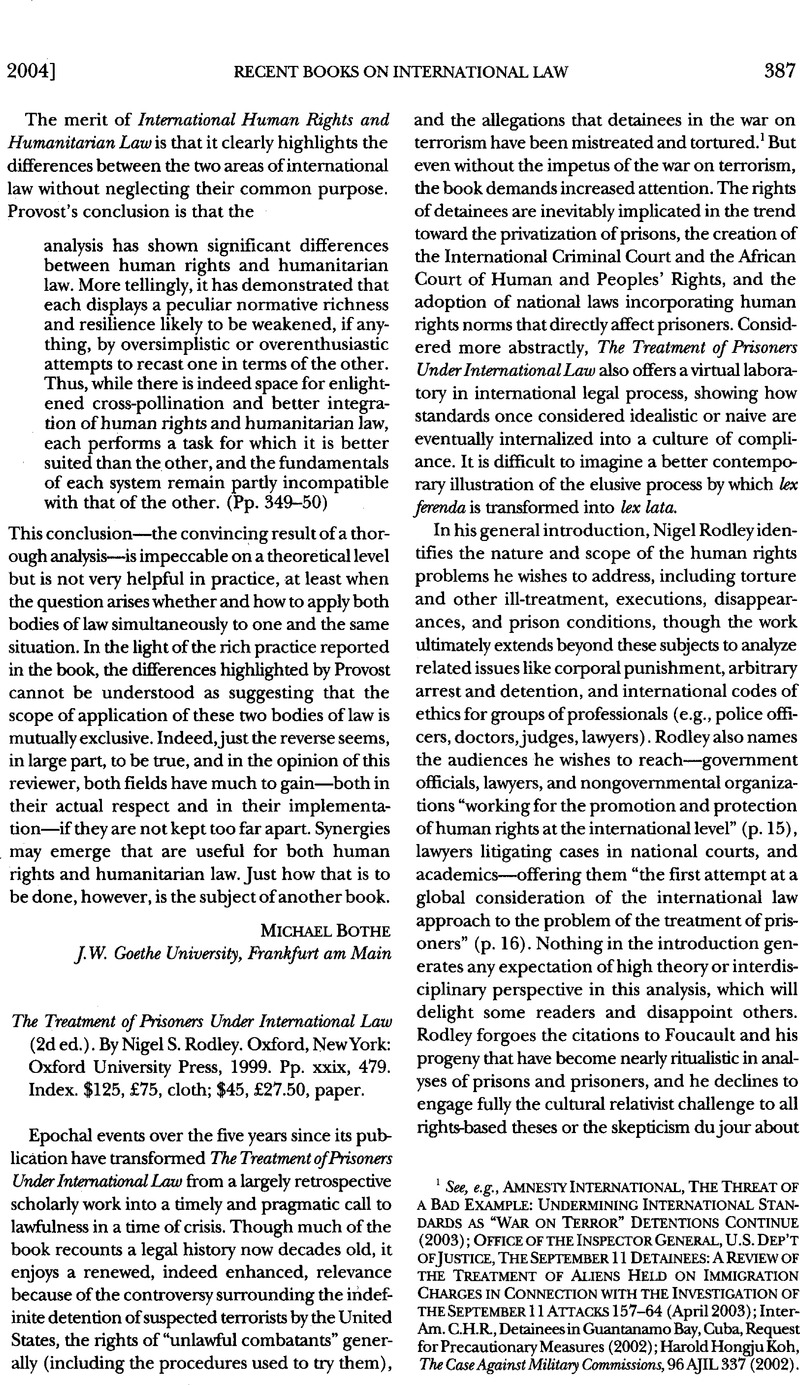No CrossRef data available.
Article contents
The Treatment of Prisoners Under International Law (2d ed.). By Nigel S. Rodley. Oxford, New York: Oxford University Press, 1999. Pp. xxix, 479. Index. $125, £75, clodi; $45, £27.50, paper.
Published online by Cambridge University Press: 27 February 2017
Abstract

- Type
- Recent Books on International Law
- Information
- Copyright
- Copyright © American Society of International Law 2004
References
1 See, e.g., Amnesty International, The Threat of A Bad Example: Undermining International Standards as “War on Terror” Detentions Continue (2003); Office of The Inspector General, U.S. Dep’t of Justice, The September 11 Detainees: A Review of The Treatment of Aliens Held on Immigration Charges in Connection with the Investigation of The September 11 Attacks 157–64 (April 2003)Google Scholar; Inter-Am, C.H.R., Detainees in Guantanamo Bay, Cuba, Request for Precautionary Measures (2002)Google Scholar; Harold, Hongju Koh, The Case Against Military Commissions, 96 AJIL 337 (2002)Google Scholar.
2 See, e.g., GA Res. 3059 (XXVIII) (Nov. 2, 1973); GA Res. 3218 (XXIX) (Nov. 6, 1974). The continuing concern mobilized in these resolutions led to the Declaration on the Protection of All Persons from Being Subjected to Torture and Other Cruel, Inhuman or Degrading Treatment or Punishment, GA Res. 3452 (XXX) (Dec. 9, 1975) [hereinafterTorture Declaration], and the Body of Principles for the Protection of All Persons Under Any Form of Detention or Imprisonment, GA Res. 43/173, annex (Dec. 9, 1988).
3 Rodley touches only briefly on the uncontroversial inclusion of the norm condemning torture in die Universal Declaration of Human Rights and subsequent treaties. The travaux of each of these instruments have been thoroughly explicated elsewhere, but Rodley does show how the impetus for wide-scale standard setting (and the move toward meaningful enforcement) came when UN entities turned a sharp public eye on the discrepancy between the practices of some states and their international obligations.
4 Compare, e.g., Torture Declaration, supra note 2, and the United Nations Convention Against Torture and Other Cruel, Inhuman or Degrading Treatment or Punishment, GA Res. 39/46, annex (Dec. 10, 1984).
5 These include, inter alia, the Torture Convention, regional conventions, and various “soft law” instruments like the Standard Minimum Rules for the Treatment of Prisoners, the Code of Conduct for Law Enforcement Officials, and the Body of Principles for the Protection of All Persons Under Any Form of Detention or Imprisonment.
6 Friedmann, Wolfgang, The Changing Structure of International Law 62 (1964)Google Scholar; see also James, Wilford Garner, Le développement et les tendences récentes du droit international, 35 Recueil des Cours 605, 641 (1931)Google Scholar.
7 Anne-Marie, Slaughter, A Typobgy of Transfudicial Communication, in International Law Decisions in National Courts 37 (Thomas, M. Franck & Gregory, H. Fox eds., 1997)Google Scholar.
8 See, e.g., Alan, M. Dershowitz, Why Terrorism Works 132–63 (2002)Google Scholar (considering torture, in certain circumstances, as a justified and effective means to combat terrorism).
9 Guidelines on the Role of Prosecutors, Eighth United Nations Congress on the Prevention of Crime and the Treatment of Offenders, UN Doc. A/CONF.144/28/Rev.l,atl89 (1990), available at <http://www.unhchr.ch/html/menu3/b/h_comp45.htm>.
10 Id.




